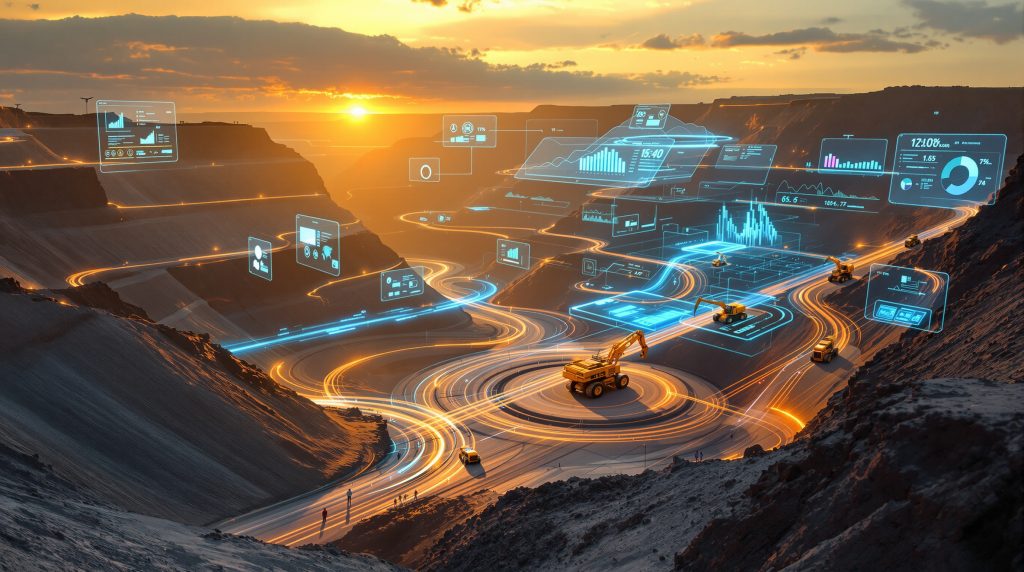The mining industry stands at a pivotal moment where revolutionizing mining with digital technologies has evolved from experimental innovation to operational imperative. The convergence of artificial intelligence, autonomous systems, and interconnected sensor networks has created unprecedented opportunities to reimagine how mineral resources reach global markets. This technological shift represents more than incremental improvement; it fundamentally alters the operational architecture of mining enterprises worldwide.
Core Digital Infrastructure Reshaping Mining Operations
The foundation of contemporary mining digitalization rests upon four interconnected technological pillars that collectively transform operational capabilities. Autonomous systems deployment has expanded beyond experimental trials to become integral infrastructure across extraction, transport, and processing operations. These systems integrate GPS guidance, radar detection, and laser positioning to create self-navigating equipment networks that operate with precision unattainable through human control alone.
IoT sensor networks form the sensory apparatus of modern mines, creating continuous data streams about equipment performance, environmental conditions, and operational parameters. These interconnected devices generate real-time operational intelligence by monitoring everything from equipment vibration patterns to atmospheric gas concentrations, enabling predictive responses rather than reactive problem-solving.
Furthermore, AI-driven predictive analytics processes this sensor data to identify operational patterns and predict equipment failures before they occur. Machine learning algorithms analyze thousands of operational variables simultaneously, replacing traditional reactive maintenance schedules with predictive models that optimize equipment lifecycle management and minimize unplanned downtime.
Cloud-based data integration platforms unify information from multiple mining sites, creating centralized operational coordination capabilities. This integration enables mining companies to optimize resource allocation across geographic locations while maintaining real-time visibility into all operational aspects.
Quantifying Digital Transformation Benefits
The operational advantages of digital mining technologies demonstrate measurable improvements across multiple performance indicators. Productivity gains through automation typically range from 15-25%, driven primarily by continuous operation capabilities that eliminate shift changeover delays and maintain consistent operational tempo.
Safety improvements represent perhaps the most significant transformation area, with workplace incident reductions of 40-60% documented through autonomous system deployment. This dramatic safety enhancement results from removing human operators from hazardous environments while maintaining operational capacity through remote monitoring and automated processes.
Cost optimization benefits emerge through operational expense reductions of 10-20%, achieved through improved fuel efficiency, reduced labor requirements, and optimized equipment utilization. These savings compound over time as predictive maintenance extends equipment lifecycles and prevents costly emergency repairs.
Environmental impact reduction reaches 30% lower carbon emissions per tonne extracted, accomplished through optimized equipment routing, improved energy efficiency, and reduced waste generation from precision extraction techniques.
Autonomous Fleet Management Systems
Autonomous fleet safety represents the most visible manifestation of mining automation, with GPS-guided fleet management capabilities reducing fuel consumption by 12-18% through optimized routing and consistent operational patterns. These systems eliminate the variability inherent in human-operated equipment, maintaining optimal speeds, routes, and loading procedures that maximize fuel efficiency across entire fleet operations.
Continuous operation capabilities fundamentally alter mining productivity calculations by eliminating shift changeover downtime. Traditional mining operations lose productive capacity during shift transitions, equipment checks, and operator briefings. Autonomous systems maintain operational continuity 24 hours daily, significantly increasing total productive capacity without proportional increases in operating costs.
Predictive routing algorithms represent sophisticated optimization systems that analyze real-time operational data to determine optimal load distribution patterns. These systems consider factors including equipment availability, route conditions, processing capacity, and delivery schedules to minimize total operational time while maximizing throughput efficiency.
In addition, remote fleet monitoring from centralized command centers enables single operators to oversee multiple autonomous vehicles simultaneously. This concentration of operational control reduces labor requirements while improving coordination between different operational areas within mining sites.
Robotic Process Integration
Automated drilling systems achieve precision levels approaching 99.5% accuracy in ore targeting through computer-controlled positioning and real-time geological data integration. These systems combine geological survey data with drilling parameters to ensure maximum ore recovery while minimizing waste rock extraction.
Robotic tunnel boring reduces excavation time by 25-35% compared to conventional drilling methods. These systems maintain consistent excavation rates while adapting to changing geological conditions through sensor feedback and automated adjustment protocols.
Unmanned loading equipment operates in hazardous environments where human presence would create unacceptable safety risks. These systems handle materials in areas with toxic gas concentrations, unstable ground conditions, or extreme temperatures while maintaining operational productivity.
Consequently, integrated safety protocols prevent human exposure to dangerous zones by creating automated exclusion perimeters around active equipment. These protocols use proximity sensors and communication systems to ensure human workers remain safely separated from autonomous operations.
Comprehensive IoT Monitoring Networks
Real-time environmental monitoring systems provide continuous assessment of operational conditions through strategically positioned sensor networks. Gas detection sensors deliver instant hazard alerts when atmospheric conditions exceed safe operational thresholds, triggering automated ventilation responses and personnel evacuation procedures when necessary.
Seismic monitoring networks predict ground instability through continuous measurement of subsurface movement patterns. These systems identify potentially dangerous conditions before they manifest as cave-ins, rockfalls, or other geological hazards that threaten equipment and personnel safety.
Air quality sensors ensure worker safety compliance by monitoring dust levels, chemical concentrations, and oxygen availability throughout mining facilities. These sensors maintain continuous records for regulatory reporting while triggering immediate responses when conditions approach dangerous levels.
Equipment vibration analysis prevents catastrophic failures through continuous monitoring of machinery operating characteristics. Sensors detect bearing wear, alignment problems, and component fatigue before these conditions cause equipment breakdown and operational disruption.
Predictive Maintenance Through Data Integration
Machine learning algorithms processing over 10,000 data points per minute enable unprecedented insight into equipment performance patterns. These systems analyze sensor data from multiple sources simultaneously, identifying subtle performance variations that indicate developing maintenance requirements.
Predictive failure models reduce unplanned downtime by 45% through early identification of components approaching failure thresholds. These models consider equipment age, operational intensity, environmental conditions, and performance trends to predict maintenance needs with remarkable accuracy.
Component lifecycle optimization extends equipment lifespan through precisely timed maintenance interventions. Rather than replacing components on predetermined schedules, predictive systems identify the optimal replacement timing based on actual condition and performance data.
Furthermore, automated maintenance scheduling coordinates maintenance activities with production requirements to minimize operational disruption. These systems automatically generate work orders, schedule technician availability, and coordinate parts procurement to ensure maintenance occurs during planned downtime periods.
Artificial Intelligence in Resource Optimization
AI-powered exploration capabilities transform geological analysis through machine learning models that process geological survey data to identify mineral deposit patterns invisible to traditional analysis methods. These systems analyze rock formations, mineral compositions, and structural features to predict ore body locations with unprecedented accuracy.
Pattern recognition algorithms improve ore body identification accuracy by analyzing complex geological data sets that exceed human analytical capacity. These systems identify subtle geological indicators that suggest mineral presence, enabling more targeted exploration activities and reducing exploration costs.
Automated core sample analysis reduces processing time by 70% through computer vision systems that identify mineral content faster and more consistently than human analysts. These systems photograph, measure, and analyze core samples automatically, creating detailed geological records while accelerating exploration timelines.
Predictive modeling for reserve estimation creates sophisticated mathematical models of mineral deposits based on limited sampling data. For instance, these models extrapolate from known data points to estimate total reserves with confidence intervals that inform investment and operational planning decisions.
Intelligent Process Control Systems
Real-time ore sorting using computer vision technology enables precise material separation based on mineral content, colour, density, and other characteristics. These systems process materials at high speeds while maintaining sorting accuracy that maximises valuable mineral recovery and minimises waste processing.
Energy consumption optimization reduces power costs by 15% through intelligent load management systems that coordinate equipment operation with electrical demand patterns. These systems automatically adjust equipment operation to minimise peak demand charges while maintaining production targets.
Production scheduling algorithms maximise throughput efficiency by coordinating activities across all operational areas. These systems consider equipment availability, material flows, processing capacity, and delivery schedules to create optimal production sequences that minimise bottlenecks and maximise overall productivity.
Quality control automation ensures consistent output standards through continuous monitoring and adjustment of processing parameters. These systems maintain product specifications automatically while adapting to variations in input materials and processing conditions.
Digital Twin Technology Implementation
Virtual mine modeling creates comprehensive 3D digital replicas that enable scenario testing before implementing operational changes. These models incorporate geological data, equipment specifications, and operational parameters to create accurate virtual representations of physical mining operations.
Real-time synchronization between physical and virtual operations ensures digital twins accurately reflect current conditions through continuous data feeds from IoT sensors and operational systems. This synchronization enables real-time optimization decisions based on current rather than historical operational states.
Modern mine planning for equipment placement and workflow optimization uses digital twin technology to test different operational configurations without disrupting actual mining activities. These models identify optimal equipment positioning, workflow sequences, and resource allocation strategies before implementation.
Risk assessment simulations reduce operational uncertainties by testing various scenarios including equipment failures, geological changes, and market condition variations. These simulations help mining companies prepare contingency plans and optimise operational resilience.
Integrated Planning and Performance Analytics
Cross-functional data integration connects information from exploration, extraction, processing, and shipping operations to create comprehensive operational visibility. This integration enables coordination between operational areas that traditionally operated independently.
Dynamic production planning responds to market demand changes through flexible operational scheduling that adjusts production levels and product mix based on real-time market conditions and customer requirements.
Resource allocation optimization across multiple mining sites coordinates equipment, personnel, and materials to maximise overall operational efficiency rather than optimising individual sites in isolation.
Performance benchmarking against industry standards provides continuous assessment of operational performance relative to peer companies, identifying improvement opportunities and competitive advantages.
Aerial Surveillance and Monitoring
High-resolution terrain mapping capabilities enable comprehensive geological assessment covering over 1,000 hectares per day through advanced imaging systems that capture detailed surface characteristics, geological features, and topographical variations with centimetre-level accuracy.
Volumetric analysis for stockpile management provides precise inventory tracking through photogrammetric techniques that calculate material volumes from aerial imagery. These systems enable accurate inventory management without manual surveying while providing historical tracking of material accumulation and depletion patterns.
Geological feature identification uses multispectral imaging to detect mineral compositions, structural features, and geological formations that indicate potential ore deposits. These systems analyse reflected light patterns to identify materials invisible to conventional photography.
Progress monitoring for large-scale infrastructure projects provides regular documentation of construction activities, earthwork progress, and facility development through comparative analysis of sequential aerial surveys.
Safety and Environmental Applications
Hazardous area inspections eliminate human risk exposure by enabling detailed assessment of unstable ground conditions, toxic gas accumulations, and equipment hazards through remote aerial observation. These inspections provide critical safety information without endangering personnel.
Environmental compliance monitoring supports regulatory reporting through systematic documentation of environmental conditions, habitat impacts, and restoration progress. These systems create comprehensive records for regulatory submissions while identifying potential compliance issues before they become violations.
Wildlife and vegetation impact assessment monitors ecological effects of mining operations through regular aerial surveys that document habitat changes, animal populations, and vegetation recovery in mining areas.
However, emergency response coordination provides critical situational awareness during accidents, equipment failures, and natural disasters through rapid aerial assessment capabilities that inform rescue operations and resource deployment decisions.
Advanced Communication Infrastructure
5G network implementation in remote mining locations enables ultra-low latency connectivity essential for real-time automation systems. These networks provide the communication infrastructure necessary for autonomous equipment coordination, remote monitoring, and instantaneous response to changing operational conditions.
High-bandwidth data transmission supports video analytics, real-time sensor monitoring, and complex data processing applications that require rapid communication between operational systems and centralised control facilities.
Edge computing capabilities reduce data processing delays by performing analytical calculations locally rather than transmitting all data to distant processing centres. This distributed computing architecture improves response times while reducing communication bandwidth requirements.
Redundant network architecture ensures operational continuity through multiple communication pathways that maintain connectivity even when primary communication systems experience failures or interruptions.
Data Management and Security
Centralised data lakes aggregate operational information from multiple mining sites, creating comprehensive databases that support enterprise-wide analysis and optimization. These systems integrate geological data, operational metrics, financial information, and market data to provide holistic business intelligence.
Scalable computing resources handle peak analytical workloads through cloud-based systems that automatically adjust processing capacity based on current demand. This flexibility ensures analytical capabilities remain available during high-demand periods without maintaining excess capacity during normal operations.
Cybersecurity frameworks protect critical operational data through multiple layers of security including network isolation, data encryption, access controls, and intrusion detection systems specifically designed for industrial control environments.
Integration platforms connect legacy systems with modern technologies through standardised interfaces that enable data exchange without requiring complete system replacement. These platforms preserve existing investments while enabling new technological capabilities.
Sustainability Through Digital Innovation
Carbon footprint tracking systems monitor environmental impact across all operational phases through continuous measurement of energy consumption, transportation emissions, and processing inefficiencies. These systems provide detailed environmental accounting that supports sustainability reporting and carbon reduction initiatives.
Water usage optimization through intelligent recycling systems reduces environmental impact while decreasing operational costs. These systems monitor water quality, optimise treatment processes, and maximise water reuse throughout mining operations.
Sustainable mining transformation using precision extraction techniques minimises environmental disruption by extracting only valuable materials while leaving waste rock undisturbed. These techniques reduce the total volume of material requiring processing and disposal.
Rehabilitation planning uses predictive ecological modeling to design post-mining land use that maximises environmental recovery. These models consider soil conditions, climate patterns, and ecological requirements to create effective restoration plans.
Regulatory Compliance Automation
Automated environmental data collection eliminates manual monitoring while ensuring comprehensive regulatory compliance through continuous measurement and recording of environmental parameters required for regulatory submissions.
Real-time compliance monitoring prevents violations by immediately identifying conditions that approach regulatory limits, enabling corrective action before violations occur.
Transparent reporting systems build stakeholder trust through accessible environmental and operational reporting that demonstrates corporate responsibility and regulatory compliance.
Sustainability metrics integration incorporates environmental performance measures into operational dashboards, ensuring environmental considerations influence operational decision-making processes.
Implementation Challenges and Considerations
Technical integration challenges arise when retrofitting existing equipment with modern sensor technology and connectivity systems. Legacy equipment often requires significant modification to integrate with digital monitoring systems while maintaining operational reliability and safety certifications.
Data standardisation across different equipment manufacturers creates interoperability challenges when integrating systems from multiple vendors into unified operational platforms. These challenges require careful planning and often custom integration solutions.
Cybersecurity vulnerabilities in connected operational systems create new risk categories that mining companies must address through comprehensive security protocols specifically designed for industrial environments with safety-critical operations.
Skills gap challenges require specialised technical training programs to develop workforce capabilities in digital system operation, maintenance, and troubleshooting. These training requirements represent significant ongoing investments in human capital development.
Financial and Strategic Considerations
High upfront capital requirements for comprehensive digitalization often require significant financial commitments that must be justified through detailed business case analysis and long-term strategic planning.
ROI timelines spanning 3-5 years for full technology implementation require patient capital and sustained management commitment to realise the full benefits of digital transformation initiatives.
Ongoing maintenance and upgrade costs for digital infrastructure represent continuing operational expenses that must be budgeted and managed as part of total operational costs.
Risk management strategies for technology adoption failures require contingency planning and risk mitigation approaches that ensure operational continuity during technology implementation and potential system failures.
Future Technology Horizons
Quantum computing applications for complex geological modeling promise unprecedented analytical capabilities for understanding subsurface conditions, ore body characteristics, and optimal extraction strategies through computational power that exceeds current technological limitations.
Advanced robotics enabling fully autonomous underground operations will extend automation beyond surface mining to underground environments where human access limitations create significant operational challenges and safety concerns.
Blockchain technology for supply chain transparency provides immutable records of mineral extraction, processing, and transportation that ensure product traceability and ethical sourcing verification throughout global supply chains.
Augmented reality systems enhance worker training and safety through immersive educational experiences that prepare personnel for hazardous conditions while providing real-time operational guidance during complex procedures.
Industry Transformation Projections
The industry evolution trends project that 80% of major operations will implement AI systems by 2027, representing a fundamental shift in how mining companies analyse operational data and make strategic decisions. This widespread adoption will create competitive pressures that accelerate digital transformation across the entire industry.
Autonomous equipment is projected to handle 60% of material movement operations, fundamentally altering workforce requirements and operational management approaches. This transformation will require significant retraining investments and operational procedure modifications.
Digital twin adoption reaching 90% of Tier 1 mining companies will standardise virtual modeling and simulation as essential operational tools rather than experimental technologies. This adoption will create new professional specialisations and technical service markets.
Integrated sustainability reporting will become mandatory across jurisdictions, requiring comprehensive environmental monitoring and reporting capabilities that depend heavily on digital data collection and analysis systems.
| Technology Category | Primary Benefit | Implementation Timeline | ROI Expectation |
|---|---|---|---|
| Autonomous Systems | 25% productivity increase | 12-18 months | 2-3 years |
| IoT Monitoring | 45% downtime reduction | 6-12 months | 18-24 months |
| AI Analytics | 20% cost optimisation | 18-24 months | 3-4 years |
| Digital Twins | 30% planning efficiency | 24-36 months | 4-5 years |
| Drone Technology | 60% survey time reduction | 3-6 months | 12-18 months |
The Path Forward for Revolutionizing Mining with Digital Technologies
The transformation of mining through digital technologies represents a paradigm shift that extends beyond operational efficiency improvements to fundamental changes in how mining companies operate, compete, and interact with environmental and social responsibilities. Success in this digital transformation requires strategic technology adoption, comprehensive workforce development, and sustained investment commitment across all organisational levels.
Mining companies that effectively navigate this technological evolution will establish competitive advantages that extend well beyond operational metrics to include safety leadership, environmental stewardship, and regulatory compliance excellence. As the industry continues to embrace these digital innovations, revolutionizing mining with digital technologies will become the standard rather than the exception.
Furthermore, the comprehensive adoption of these technologies across the mining sector will fundamentally reshape how we extract, process, and utilise mineral resources in an increasingly demanding global economy. The companies that recognise this transformation early and invest accordingly will lead the future of mining technology for decades to come.
"Disclaimer: This analysis is based on industry trends and technological developments as of November 2025. Technology adoption timelines, performance metrics, and return on investment projections may vary significantly based on specific operational conditions, geological factors, and implementation approaches. Mining companies should conduct thorough feasibility studies and risk assessments before implementing large-scale digital transformation initiatives. Past performance of digital technologies does not guarantee future results, and operational improvements may be influenced by factors beyond technological implementation including market conditions, regulatory changes, and geological variations."
Ready to Invest in the Digital Mining Revolution?
Discovery Alert's proprietary Discovery IQ model delivers real-time alerts on significant ASX mineral discoveries from companies embracing cutting-edge digital technologies, instantly empowering subscribers to identify actionable opportunities ahead of the broader market. Begin your 30-day free trial today and secure your market-leading advantage as the mining industry undergoes this technological transformation.




